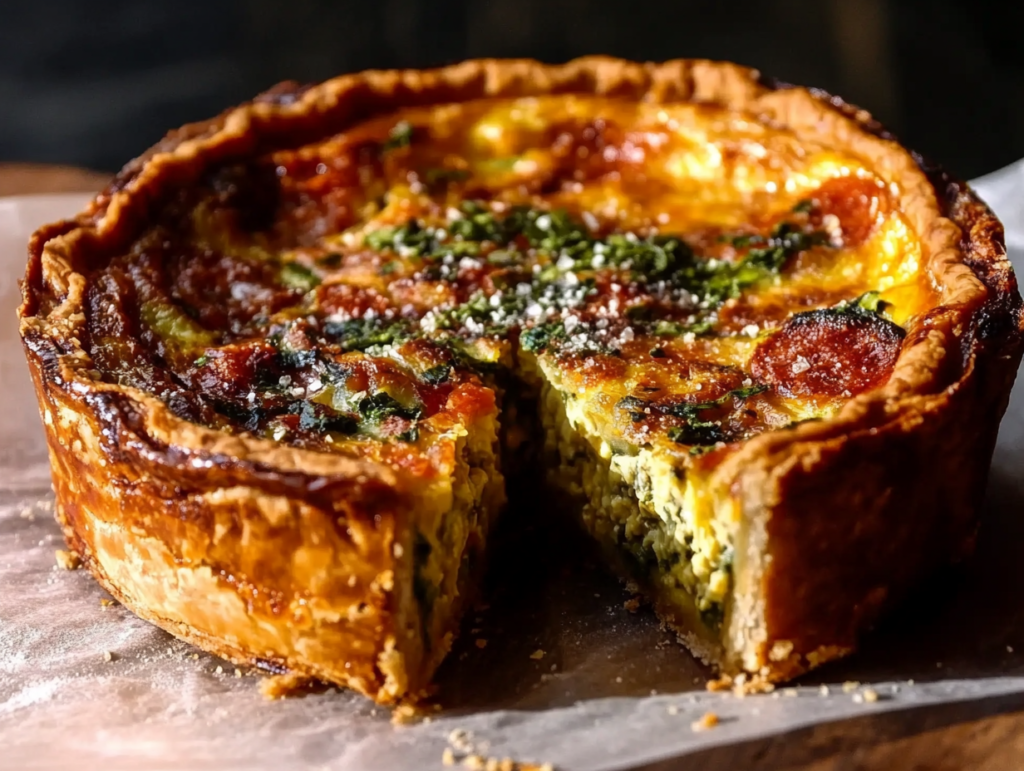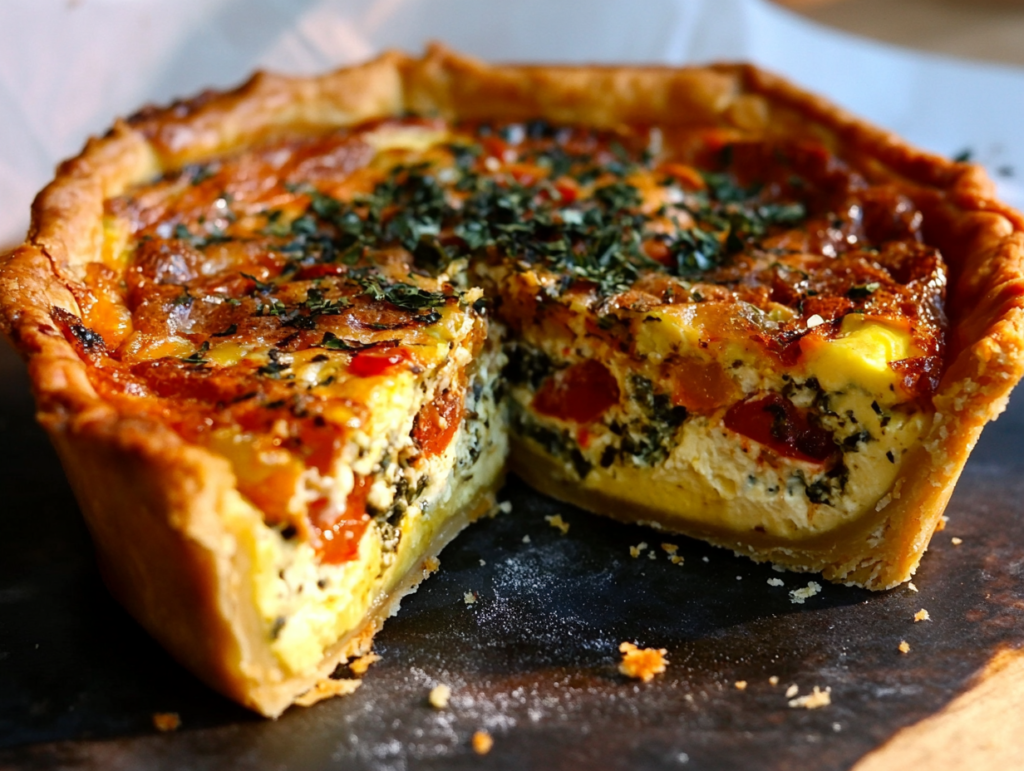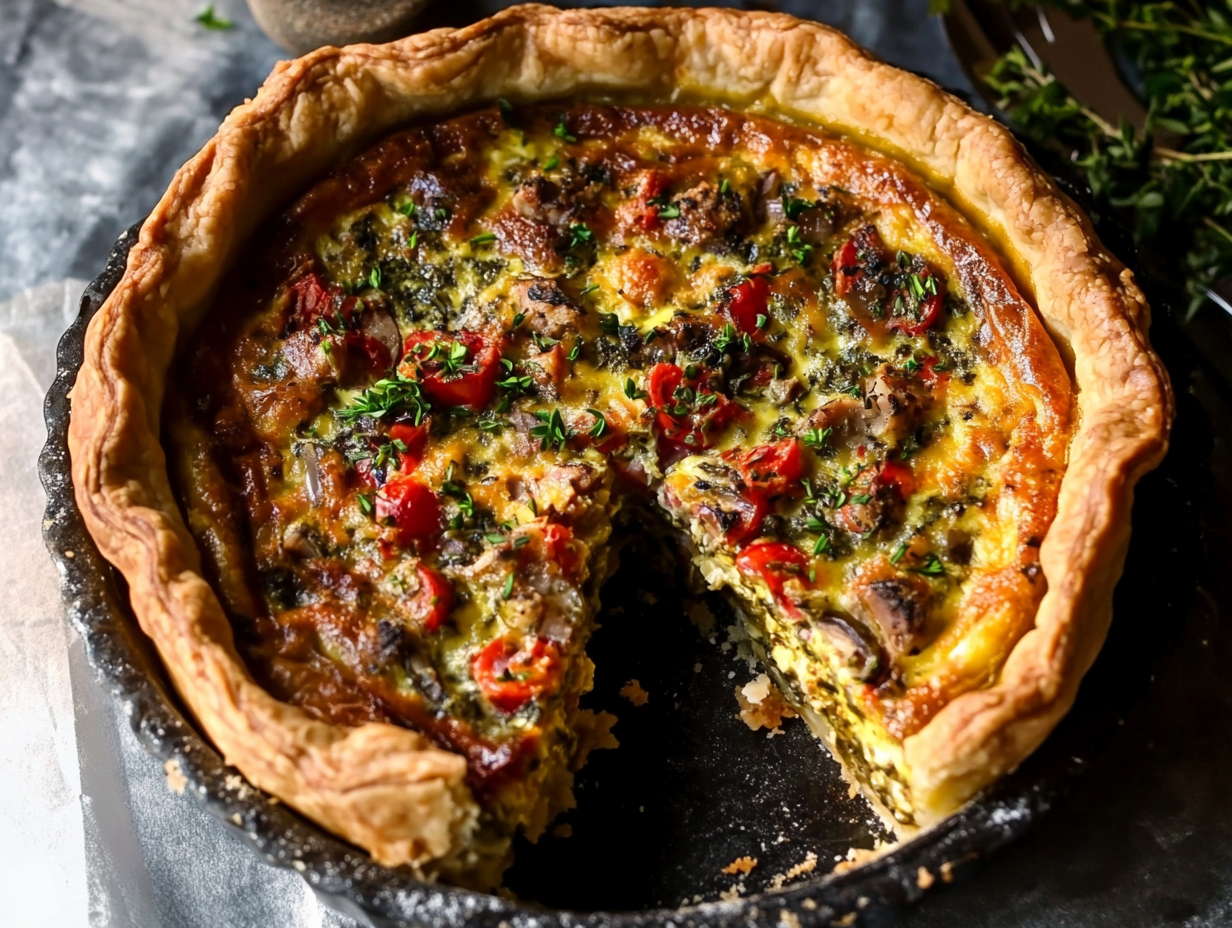A deep dish quiche recipe is the ultimate guide to creating a rich and flavorful dish with a flaky crust and hearty fillings. Perfect for brunches, dinners, or celebrations, this versatile recipe will impress everyone at your table.

What is a Deep Dish Quiche?
Origin of Quiche and its Variants
The quiche originated in Germany’s medieval kingdom of Lothringen, now Lorraine, France. The term “quiche” derives from the German word “kuchen,” meaning cake. Traditionally, quiche Lorraine, the original variant, featured a simple filling of eggs, cream, and smoked bacon.
Over time, quiches have evolved to incorporate a variety of ingredients, such as vegetables, cheeses, meats, and seafood, leading to many popular variations like spinach quiche, seafood quiche, and vegetarian options.
Difference Between Regular and Deep Dish Quiches
The key distinction lies in the crust and filling:
- Regular Quiche: Uses a shallow crust, holding a modest layer of filling. It’s lighter and often quicker to bake.
- Deep Dish Quiche: Features a thicker crust and significantly more filling, allowing for more layers of flavor and heartier portions.
Why Choose a Deep Dish Quiche?
- Flavor-packed Layers: The deep crust accommodates more ingredients, leading to complex, satisfying bites.
- Presentation: Its towering height and golden crust create a stunning centerpiece for any table.
- Meal Versatility: Serve it warm, cold, or at room temperature; it’s perfect for any time of the day.
Essential Tools and Equipment
Must-Have Baking Tools
To craft the perfect deep dish quiche recipe, you’ll need:
- Rolling Pin: For flattening the pastry dough evenly.
- Mixing Bowls: For combining your ingredients efficiently.
- Whisk: Helps achieve a smooth, well-mixed custard base.
- Measuring Cups and Spoons: Ensures precise ingredient ratios.
Best Pans for Deep Dish Quiche Recipe
The choice of pan significantly impacts your quiche’s structure:
- Deep-Dish Pie Pan: Ideal for creating thick, even crusts with straight sides.
- Springform Pan: Allows for easy removal, making it perfect for elaborate presentations.
- Tart Pan with Removable Bottom: A reliable option for ensuring an attractive, professional look.
Optional Equipment for Perfect Results
For extra finesse:
- Pastry Cutter: Helps blend butter and flour seamlessly for a flaky crust.
- Pie Weights or Beans: Prevents the crust from puffing up during blind baking.
- Food Processor: Speeds up dough preparation, creating consistent results.
- Silicone Mat or Parchment Paper: Assists in rolling out dough and prevents sticking.
Ingredients for a Deep Dish Quiche Recipe
Creating the perfect deep dish quiche begins with choosing the right ingredients. From a buttery crust to a creamy filling, each component plays a vital role in achieving culinary perfection.
Base Ingredients (Crust, Eggs, and Cream)
- Crust: The foundation of the quiche, a buttery and flaky crust, provides both texture and flavor. A homemade crust is ideal, but store-bought options work well in a pinch.
- All-purpose flour
- Unsalted butter (cold)
- Ice water
- Pinch of salt
- Eggs: The binding agent, eggs create the quiche’s velvety texture. Typically, 4-6 eggs are required for a deep dish.
- Cream: For a rich and luxurious filling, heavy cream or a combination of cream and whole milk is recommended. Opt for a 1:1 ratio for the perfect balance.
Choosing the Right Fillings
Fillings transform a basic quiche into a personalized masterpiece. Here are some popular options:
- Vegetables: Spinach, mushrooms, onions, bell peppers, asparagus, and tomatoes.
- Proteins: Bacon, ham, sausage, chicken, smoked salmon, or crab.
- Cheeses: Gruyère, cheddar, feta, goat cheese, or Swiss.
Secret Ingredients for Extra Flavor
To elevate your quiche:
- Fresh Herbs: Add a sprinkle of thyme, chives, parsley, or dill for freshness.
- Spices: Nutmeg and black pepper enhance the custard’s depth.
- Aromatics: Sautéed garlic or shallots infuse the quiche with aromatic richness.
- Zest or Mustard: A hint of lemon zest or Dijon mustard can brighten and balance the flavors.

Preparing the Crust
The crust is the canvas for your quiche, and preparing it correctly is key to success.
Traditional Crust Recipe
Ingredients:
- 2 ½ cups all-purpose flour
- 1 cup unsalted butter (cold, diced)
- 6-8 tablespoons ice water
- ½ teaspoon salt
Method:
- In a mixing bowl, combine flour and salt.
- Cut in the butter with a pastry cutter or your fingers until the mixture resembles coarse crumbs.
- Gradually add ice water, one tablespoon at a time, mixing until the dough just holds together.
- Shape the dough into a disc, wrap it in plastic, and refrigerate for at least 30 minutes.
Gluten-Free and Other Variations
For dietary preferences or allergies, try these crust alternatives:
- Gluten-Free Crust: Substitute almond flour, oat flour, or gluten-free flour blends.
- Sweet Potato Crust: Thinly slice sweet potatoes and layer them in the pan as a gluten-free, nutrient-packed alternative.
- Cauliflower Crust: Use riced cauliflower mixed with cheese and egg for a low-carb option.
Pre-Baking Tips for a Flaky Crust
- Chill the Dough: Cold dough prevents butter from melting too quickly, ensuring a flaky texture.
- Roll Evenly: Roll the dough to about ¼ inch thickness for an even bake.
- Blind Bake: Line the crust with parchment paper, fill with pie weights, and bake at 375°F (190°C) for 15-20 minutes. Remove weights and bake for an additional 5 minutes.
Making the Filling
The filling is the heart of a deep dish quiche recipe. A perfectly balanced mixture of eggs, cream, cheese, and complementary ingredients creates a rich and satisfying dish.
Crafting a Rich Egg Mixture
The egg mixture acts as the base for your filling, binding all the ingredients together and providing a creamy texture.
Basic Recipe:
- 4-6 large eggs
- 1 cup heavy cream
- 1 cup whole milk (optional: replace with more cream for extra richness)
- Pinch of salt and black pepper
- Optional: ¼ teaspoon ground nutmeg for a subtle depth of flavor
Method:
- In a mixing bowl, whisk the eggs until smooth.
- Gradually add the cream and milk, whisking continuously to combine.
- Season with salt, pepper, and any desired spices or herbs (e.g., thyme, parsley, or chives).
Balancing Flavors with Cheese and Vegetables
Cheese and vegetables add layers of flavor and texture to your quiche.
Cheese Options:
- Gruyère: A classic choice for its nutty, creamy flavor.
- Cheddar: Sharp and tangy, pairs well with hearty fillings.
- Feta: Salty and crumbly, great for Mediterranean-inspired quiches.
- Goat Cheese: Adds a tangy creaminess.
Vegetables:
- Sautéed onions, mushrooms, or bell peppers for a savory touch.
- Spinach or kale for a nutrient-packed addition.
- Roasted asparagus or cherry tomatoes for pops of flavor.
Tip: Sauté vegetables before adding them to the quiche to remove excess moisture, preventing a soggy crust.
Adding Protein Options (Ham, Bacon, Chicken)
Proteins elevate your quiche to a hearty, meal-worthy dish.
- Ham: Diced or sliced, its salty, smoky flavor pairs beautifully with Gruyère and spinach.
- Bacon: Crispy crumbled bacon adds a rich, smoky element.
- Chicken: Cooked and shredded chicken works well with creamy cheeses like goat cheese or Swiss.
- Seafood: For a unique twist, try smoked salmon or cooked crabmeat.
Tip: Use cooked proteins to avoid excess liquid in the quiche.
Layering the Ingredients
Proper layering ensures an even distribution of flavors and prevents common pitfalls like soggy crusts or uneven cooking.
The Importance of Layering
Layering ensures every bite includes a balanced mix of ingredients.
Order of Layers:
- Cheese: Sprinkle a layer of cheese directly onto the pre-baked crust. This creates a barrier to protect the crust from becoming soggy.
- Vegetables and Proteins: Arrange these evenly across the cheese layer.
- Egg Mixture: Pour the egg mixture gently over the solid ingredients, ensuring even coverage.
Avoiding a Soggy Quiche
Sogginess is a common issue, but these tips will keep your deep dish quiche recipe crisp and delicious:
- Pre-Bake the Crust: Blind baking helps seal the crust.
- Remove Excess Moisture: Sauté vegetables and use cooked proteins to eliminate unnecessary liquids.
- Don’t Overfill: Leave a slight gap at the top to prevent the filling from spilling over during baking.
Tips for Even Cooking
Achieving an evenly cooked quiche requires attention to detail:
- Distribute Ingredients Evenly: Spread fillings in a single, consistent layer.
- Bake Low and Slow: Cook at 350°F (175°C) for 45-60 minutes to allow the custard to set without overbaking.
- Check for Doneness: The quiche is ready when the edges are set, and the center jiggles slightly. It will firm up as it cools.
Baking Your Deep Dish Quiche Recipe
The baking process is critical to achieving a perfectly cooked quiche with a silky texture and golden crust. By following precise steps, you can ensure a beautiful result every time.
Temperature and Timing
Baking your quiche at the right temperature and for the correct duration is key to even cooking.
- Preheat Your Oven: Set your oven to 350°F (175°C). Consistent heat is vital for proper baking.
- Position the Pan: Place your quiche on the middle rack to ensure even heat distribution.
- Baking Time: Bake for 45-60 minutes. Cooking times may vary based on your oven and the size of your quiche.
- Tip: Check the quiche at the 40-minute mark to avoid overbaking.
How to Check for Doneness
A perfectly baked quiche has set edges and a slightly jiggly center.
- Visual Cues: The edges should be firm and lightly golden, while the center should wobble slightly when the pan is shaken.
- Toothpick Test: Insert a toothpick or knife about 2 inches from the center. It should come out mostly clean with a few moist crumbs, but no liquid.
- Thermometer: For accuracy, the internal temperature should reach 165°F (74°C).
Troubleshooting Common Baking Issues
- Undercooked Center: If the center is too runny, cover the quiche with foil and bake for an additional 5-10 minutes.
- Overbrowning Crust: If the crust browns too quickly, cover the edges with aluminum foil or a pie crust shield.
- Cracked Surface: Cracks often indicate overbaking. Lower the oven temperature slightly next time and bake longer at a gentler heat.
Cooling and Serving
Cooling is as important as baking to allow the quiche to set fully and achieve its ideal texture. Serving techniques ensure your quiche is both presentable and delicious.
How Long to Let Your Quiche Cool
- Cooling Time: Allow the quiche to cool on a wire rack for 15-20 minutes. This helps the filling set and makes slicing easier.
- Serving Temperature: Quiche can be served warm, at room temperature, or even chilled, depending on your preference.
Best Ways to Slice and Serve
Proper slicing ensures clean edges and avoids crumbling.
- Use a Sharp Knife: A serrated or very sharp knife works best for clean slices.
- Warm the Knife: Dip the blade in hot water and wipe it dry before slicing to avoid sticking.
- Slice Strategically: Cut the quiche into wedges, starting from the center. For a deep dish quiche, aim for 6-8 generous slices.
Pairing Suggestions (Salads, Wines, Sides)
Enhance your quiche with complementary pairings for a well-rounded meal.
- Salads:
- A crisp green salad with vinaigrette balances the richness of the quiche.
- Try arugula, mixed greens, or a citrus-infused salad for added brightness.
- Wines:
- White Wine: A Chardonnay or Sauvignon Blanc pairs beautifully with creamy quiches.
- Sparkling Wine: A glass of Champagne or Prosecco adds a celebratory touch.
- Sides:
- Bread: A crusty baguette or warm croissant complements the quiche.
- Roasted Vegetables: Asparagus, carrots, or Brussels sprouts make excellent accompaniments.
- Soup: A light soup like tomato bisque or vegetable broth pairs wonderfully.
FAQs About Deep Dish Quiche Recipes
Here are answers to some commonly asked questions about making and perfecting deep dish quiches.
Can I Make It Without Cream?
Yes, you can substitute heavy cream with several alternatives:
- Milk: Use whole milk for a lighter quiche, though the texture may be less rich.
- Half-and-Half: A mix of milk and cream offers a good balance of richness.
- Non-Dairy Options: Unsweetened almond milk, oat milk, or coconut milk can work for a dairy-free quiche, but these may slightly alter the flavor.
Tip: To mimic creaminess without cream, whisk in a small amount of Greek yogurt or silken tofu.
How Long Can I Store It in the Freezer?
A baked deep dish quiche can be stored in the freezer for up to 3 months if wrapped properly.
Freezing Tips:
- Let the quiche cool completely.
- Wrap it tightly in plastic wrap, followed by aluminum foil, or store it in an airtight freezer-safe container.
- To reheat, thaw overnight in the refrigerator and bake at 350°F (175°C) for 20-25 minutes.
Unbaked quiches can also be frozen, but ensure the filling and crust are tightly sealed.
What’s the Best Cheese for a Deep Dish Quiche?
The best cheese depends on the flavor profile you’re aiming for:
- Gruyère: A classic choice for its creamy, nutty flavor.
- Cheddar: Sharp and tangy, ideal for savory quiches.
- Feta: Salty and crumbly, perfect for Mediterranean-inspired recipes.
- Goat Cheese: Adds a creamy tang for gourmet flair.
- Swiss: Mild and melty, complements most ingredients.
Mixing cheeses can create a unique and layered flavor.
Is Heavy Cream or Milk Better for Quiche?
Heavy Cream is better for a richer, more luxurious texture, while Milk results in a lighter, lower-fat quiche. A combination of both is often the best approach, providing creaminess without being overly dense.
What Is the Secret to a Good Quiche?
The secret lies in balance and technique:
- Custard Ratio: Use the correct egg-to-liquid ratio (typically 1 large egg per ½ cup of cream or milk).
- Sauté Ingredients: Remove excess moisture from vegetables and proteins by pre-cooking them.
- Prebake the Crust: Blind baking ensures a crisp base.
- Season Generously: Herbs, spices, and salt enhance the custard and fillings.
- Bake Gently: Low and slow baking avoids overcooked, rubbery custard.
Is It Necessary to Prebake Pie Crust for Quiche?
Yes, prebaking (blind baking) the crust is recommended to:
- Prevent sogginess from the custard.
- Create a sturdy, golden base that holds up to the filling.
Tip: Use pie weights or dried beans during prebaking to keep the crust flat.
What’s the Difference Between a Frittata and a Quiche?
While both are egg-based dishes, there are key differences:
- Crust:
- Quiche has a pastry crust.
- Frittata is crustless, cooked entirely in a skillet or baking dish.
- Egg Mixture:
- Quiche contains cream or milk, making it custard-like.
- Frittata relies primarily on eggs, resulting in a denser texture.
- Cooking Method:
- Quiche is baked in the oven.
- Frittata starts on the stovetop and finishes under a broiler or in the oven.
When crafting the perfect deep dish quiche, starting with a flawless crust is essential. For tips on achieving this, check out this quiche crust recipe, which provides expert guidance on creating a buttery, flaky base. If you’re looking for inspiration for flavor combinations, explore this vegetable quiche recipe for delicious and nutritious ideas. Want to try something unique? A mushroom quiche recipe offers earthy flavors that complement the creamy filling. Don’t miss the crab quiche recipe for a seafood twist that’s perfect for special occasions.
For those interested in making their quiche more accessible or gluten-free, alternatives like this tortilla quiche bake recipe provide an easy and innovative crust solution.
Conclusion
A deep dish quiche is more than just a dish; it’s a versatile culinary creation that can be tailored to suit any occasion. With its flaky crust, rich custard filling, and endless combinations of ingredients, it’s the perfect choice for brunches, dinners, or celebratory events. By mastering the techniques of preparing the crust, crafting the filling, and baking to perfection, you can create a quiche that is both delicious and visually impressive.
Remember, the key to success lies in balance—pairing flavors thoughtfully, layering ingredients properly, and baking with care. Whether you stick to traditional recipes or experiment with new variations, your deep dish quiche is sure to delight and impress every time.
Happy cooking, and enjoy your masterpiece!

